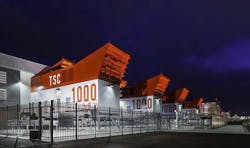Taking Tier IV to Thailand: A Modular Design for the Global Market
Las Vegas doesn’t get many major windstorms. That’s why the double roof at the Switch SUPERNAP 8 data center is a novel feature. The roof system, known as SwitchSHIELD, has two roof decks located nine feet apart that can protect the servers inside from extreme winds seen in tornadoes or hurricanes.
During a 2014 tour, Switch founder and CEO Rob Roy emphasized the importance of the SwitchSHIELD in the new building, describing it as part of a decade-long effort to rethink the data center. That’s because Roy’s design vision was already focused on new horizons beyond Las Vegas.
The fruits of that effort are being realized as Switch accelerates its global expansion. The next phase of that effort came into view last week, as Switch unveiled plans to build a data center campus in Thailand. Like many locations in southeast Asia, Thailand presents business opportunities for data center operators, but also a challenging climate that is warm, humid and rainy.
The new Switch facility will use a data center template featuring pre-fabricated components, that can recreate the reliability and efficiency of SUPERNAP 8 in any market around the world – including ones with periodic typhoons, where the double roof system will provide essential protection.
The modular SUPERNAP design, using building blocks known as MacroMODs, allows Switch to bring new levels of reliability and efficiency to Thailand. The company intends its SUPERNAP Thailand facility in Chonburi to become the first data center in Asia certified as Tier IV Gold by the Uptime Institute.
Tying Design to Business Goals
In recent stories we’ve been examining the many ways service providers are optimizing data center designs to drive their business goals. Some are adapting their facilities to offer varying levels of reliability (Data Centers Adapt as Tenants Seek Options on Power Redundancy) or density (The Density Debate: Sign of a Coming Shift).
For Switch, data center design is about delivering the very highest levels of resiliency and density for its marquee customers, hence the focus on “build once, run anywhere” Tier IV design.
That’s reflected in the list of partners in the launch announcement for SUPERNAP Thailand, which included financial organizations like CPB Equity, Siam Commercial Bank and Kasikorn Bank. Switch is also partnering with True IDC, a unit of the Ascend Group that operates several data centers in Bangkok.
“The SUPERNAP Thailand data center is a mirror of Switch SUPERNAP U.S. facilities, which are the first Tier IV Gold carrier-neutral colocation data centers on the planet,” said Khaled Bichara, the CEO of SUPERNAP International. “With Thailand’s focus on digital growth, this data center will set a new precedent for quality, security and innovation in Asia Pacific.”
The Asia-Pacific region has been a major growth market for global data center companies, with much of the development focused on financial markets including Singapore, Tokyo and Hong Kong.
In Thailand, Switch quickly becomes the leading data center player, and is working closely with the government and financial sector to raise Bangkok’s profile in the global data center business.
“The facility will play an important role to support the country’s business development by showcasing Thailand as a regional hub for data centers,” said Deepak Sarup, Chief Financial Officer of Siam Commercial Bank and Chairman of SUPERNAP Thailand. “This unique data center design will not only bring innovative technology to the Kingdom, but will also attract international investors.”
The SwitchSHIELD double-roof system inside the SUPERNAP 8 data center, which can protect the data halls from winds of up to 200 miles per hour. (Photo: Switch)
Resiliency in Any Climate
Here’s where data center design and site selection make a difference in delivering uptime amid Thailand’s combination of heat, humidity and monsoons.
The $300 million data center will be located on the Hermeraj Chonburi Industrial Estate about 70 miles south of Bangkok, where it sits 360 feet above sea level and outside the Bangkok flood zone. The area was unaffected by the massive 2011 flooding in Thailand, which led to global disruption of the market for hard disk drives. It’s also far from the area affected by the 2004 Asian tsunami, which impacted Thailand’s southern peninsula, which fronts the Pacific Ocean rather than the Gulf of Thailand.
The SwitchSHIELD double roof system provides protection against winds up to 200 miles an hour – more than enough to protect again typhoons, which occur periodically in Thailand and can bring winds up to 120 miles an hour.
The roof system is part of the MacroMOD design, which is enabling Switch to rapidly create SUPERNAP campuses in a range of climates. The company is currently developing new U.S. data center campuses in Reno and Grand Rapids, Michigan, as well as international sites in Milan, Italy and now Thailand.
Each MacroMOD consists of pre-fabricated components that can be assembled into two data halls. The building features a central power spine, with the generators and electrical infrastructure on one side, and the data halls and cooling infrastructure on the other side.
The cooling units, who are housed outside the building, are unusually versatile, supporting six different modes of cooling. The software that manages the system selects the most efficient cooling method based on the exterior temperature, humidity and other conditions. The cooling system is supported by a rotary flyhweel, which can ensure that the cooling units will continue to move air through the data halls in the event of a utility power outage.
SUPERNAP Thailand will launch with one MacroMOD in place, with room to add two more as the data halls are filled. The site supports up to 60 megawatts of power capacity, and is located near an undersea fiber optic cable landing station in Sri Racha. Upon completion, the campus will house up to 6,000 servers. The first phase of the project will come online in the first quarter of 2017.
About the Author



